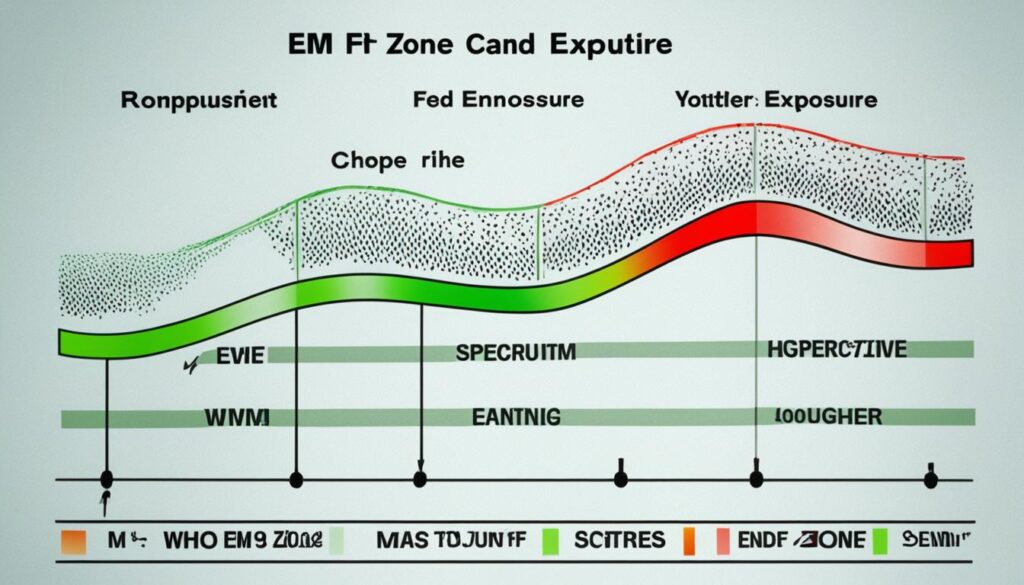Disclosure: This Post Contains Affiliate Links; We earn a commission on purchases.
The WHO Guidelines on EMF (Electromagnetic Fields) Exposure provide crucial recommendations for minimizing the health risks associated with EMF exposure. These guidelines are based on extensive scientific research and aim to protect individuals from potential adverse effects.
Electromagnetic fields (EMFs) are generated by both natural and human-made sources and can be found everywhere in our environment. They consist of electric and magnetic components and vary in frequency. While ongoing research is being conducted on the health effects of EMF exposure, some studies have suggested potential risks, including increased cancer risk, reproductive issues, and neurological disorders.
Key Takeaways:
- The WHO Guidelines on EMF Exposure offer important recommendations for minimizing health risks.
- EMFs are generated by natural and human-made sources and can have varied frequencies.
- Research suggests potential health risks associated with EMF exposure, including increased cancer risk and neurological disorders.
- The International Commission for Non-Ionizing Radiation Protection (ICNIRP) provides guidelines on RF-EMF exposure limits.
- The WHO recommends countries to adopt the ICNIRP guidelines to ensure the protection of individuals.
What are Electromagnetic Fields?
Electromagnetic fields (EMF) are generated by both natural and human-made sources and can be found everywhere in our environment. These fields consist of electric and magnetic components and vary in frequency. While ongoing research explores the health effects of EMF exposure, certain studies have suggested potential risks, including increased cancer risk, reproductive issues, and neurological disorders.
“EMF exposure has been associated with increased cancer risk, reproductive issues, and neurological disorders.”
Studies have indicated a possible link between EMF exposure and adverse health effects. For example, a study conducted by Davis et al. (2013) found that long-term exposure to high-frequency EMF emitted by mobile phones may increase the risk of brain tumors. Similarly, a study by Li et al. (2017) reported that exposure to extremely low-frequency EMF might disrupt reproductive function in males. While these studies offer valuable insights, further research is needed to fully understand the potential health risks associated with EMF exposure.
Health Risks Associated with EMF Exposure
Several potential health risks have been associated with EMF exposure:
- Cancer: Some studies have suggested a possible connection between long-term exposure to EMF and an increased risk of cancer, particularly brain tumors.
- Reproductive Issues: Research has indicated that EMF exposure may affect reproductive health, potentially leading to decreased fertility and increased risk of developmental problems in offspring.
- Neurological Disorders: Preliminary studies have suggested a potential link between EMF exposure and neurological disorders such as Alzheimer’s disease and Parkinson’s disease, though further research is needed to establish definitive conclusions.
While the scientific community continues to investigate the health effects of EMF exposure, it is important to exercise caution and take measures to minimize exposure where possible.
| Source | Findings |
|---|---|
| Davis et al. (2013) | Long-term exposure to high-frequency EMF emitted by mobile phones may increase the risk of brain tumors. |
| Li et al. (2017) | Exposure to extremely low-frequency EMF might disrupt reproductive function in males. |
ICNIRP Guidelines on RF-EMF Exposure
The International Commission for Non-Ionizing Radiation Protection (ICNIRP) is an independent scientific commission that provides guidelines on RF-EMF exposure. These guidelines, updated in 2020, establish limits to protect individuals from established health hazards associated with RF-EMF in the range of 100 kHz to 300 GHz.
Based on a thorough review of scientific literature, the ICNIRP guidelines are widely recognized and adopted by many countries worldwide. They serve as an important reference for setting standards and regulations to ensure the safety of individuals.
By setting exposure limits, the ICNIRP guidelines aim to mitigate potential risks of RF-EMF on human health. These limits take into account various factors such as frequency, duration of exposure, and specific absorption rate (SAR).
Adhering to the ICNIRP guidelines helps to protect individuals from excessive RF-EMF exposure, promoting a safer environment for both the general public and workers in various industries, including telecommunications, healthcare, and research.
It is important for policymakers, organizations, and individuals to stay informed about the latest ICNIRP guidelines to ensure compliance with recommended exposure limits and mitigate potential health risks associated with RF-EMF.

| Frequency Range | Exposure Limit |
|---|---|
| 100 kHz – 10 MHz | 28 V/m |
| 10 MHz – 300 GHz | 40-61 V/m |
WHO Recommendations for EMF Exposure
The World Health Organization (WHO) recognizes the importance of protecting individuals from the potential health risks associated with electromagnetic field (EMF) exposure. To ensure the safety of the public, the WHO recommends countries to adopt the International Commission for Non-Ionizing Radiation Protection (ICNIRP) guidelines on RF-EMF exposure.
These guidelines provide specific limits to protect individuals from established health hazards linked to RF-EMF exposure in the frequency range of 100 kHz to 300 GHz. By adhering to these guidelines, countries can establish national regulations that prioritize the well-being of their populations.
The WHO also emphasizes the need for accurate information and communication regarding EMF exposure and its potential health risks. By educating the public about the guidelines and empowering them to make informed decisions, individuals can take proactive steps to reduce their exposure and mitigate associated risks.
Furthermore, the WHO underscores the significance of ongoing research to deepen our understanding of the long-term effects of EMF exposure. Through continuous scientific investigation, we can enhance our knowledge and develop more robust guidelines and recommendations in the future.
By following the WHO recommendations and implementing the ICNIRP guidelines, countries can prioritize the health and well-being of their populations and ensure responsible EMF exposure management.

| Benefits of WHO Recommendations for EMF Exposure | Implementation Challenges |
|---|---|
|
|
Conclusion
To minimize EMF exposure and safeguard your health, it is crucial to follow certain safety measures. By implementing these EMF protection tips and electromagnetic field safety measures, you can reduce your potential health risks and promote well-being.
Firstly, make a conscious effort to maintain a distance from potential sources of high EMF emissions. Keep your distance from power lines, electrical transformers, and other known sources of electromagnetic fields. This simple step can significantly reduce your exposure to harmful EMF.
Secondly, limit the use of wireless devices whenever possible. Wireless devices like smartphones, laptops, and tablets emit RF-EMF, which can be harmful over extended periods of exposure. Opt for wired connections, such as Ethernet cables, for internet connectivity and minimize your use of Bluetooth and Wi-Fi devices.
Lastly, consider using shielding devices to reduce personal exposure. There are various options available, including EMF shielding fabrics and cases for electronic devices. These products can help minimize EMF exposure and provide an additional layer of protection.
By following these recommended precautions, you can proactively reduce your EMF exposure and protect yourself from potential health risks associated with electromagnetic fields. Stay informed, take action, and prioritize your well-being.
Source Links
- https://www.who.int/health-topics/electromagnetic-fields
- https://www.who.int/news-room/questions-and-answers/item/radiation-electromagnetic-fields
- https://www.gsma.com/publicpolicy/wp-content/uploads/2021/10/GSMA_International_EMF_Exposure_Guideline_Oct21.pdf

Subscribe to Our Newsletter










